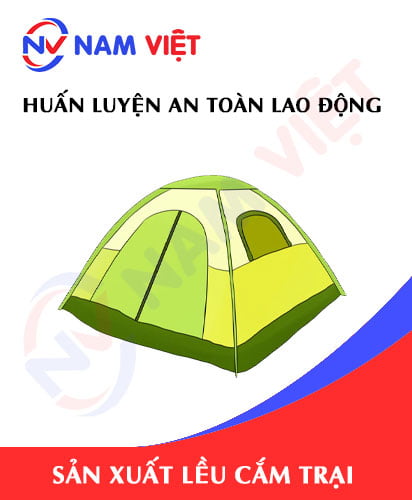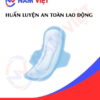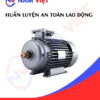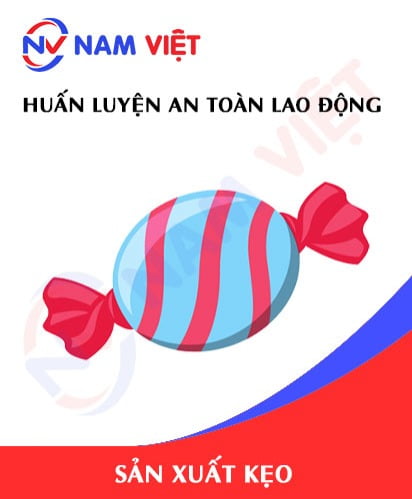Occupational safety training for camping tent manufacturing
99,000 ₫
Note: The above price is calculated per person, the price may vary depending on the number of trainees participating in the course and market fluctuations. For more accurate price support, please refer to the quotation or contact our consultants directly.
Occupational safety is an important issue in factories manufacturing camping tents and needs to be addressed promptly to ensure the health and safety of workers, enhancing the reputation of businesses. The Occupational Safety Training course is one of the effective solutions to raise awareness about how to prevent workplace accidents for workers involved in camping tent manufacturing.
Table of Contents
Toggle1. Overview of camping tents
a. What is a camping tent?
- A camping tent is a small room made of fabric or other material, used for temporary shelter and sleeping during camping or outdoor excursions. Camping tents are often made from waterproof fabric or parachute fabric to protect against environmental factors such as wind, rain, and sun.
- Camping tents can have different sizes and designs, from simple tents that can only hold one person to larger tents that can hold multiple people or are designed for use in a specific environment such as snowy areas or dense forests.
- A camping tent is one of the most important items on camping or hiking trips, helping to protect the user from adverse weather conditions and providing a private and safe space to rest.
- Currently, the camping tent manufacturing industry in Vietnam is developing with many manufacturers and brands of all sizes across the country. Vietnam is one of the countries with favorable natural conditions to develop the camping tent manufacturing industry, especially in mountainous and coastal areas.
- Vietnamese camping tent products are manufactured with many different designs, sizes, and materials to meet customer needs. In addition, many brands have focused on improving product quality and design to increase the usability and durability of camping tents.

b. Types of machinery for camping tent manufacturing
The types of machinery for camping tent manufacturing include:
- Industrial sewing machines: Sewing machines are an important tool in camping tent manufacturing. Industrial sewing machines are used to sew the details of camping tents such as fabric, mesh, zippers, and other accessories.
- Automatic fabric cutting machines: Automatic fabric cutting machines are used to cut fabric into the necessary shapes to form the parts of the camping tent.
- Vacuum welding machines: Vacuum welding machines are used to join parts of the camping tent together using high temperature and steam pressure.
- Digital printing machines: Digital printing machines are used to print images or logos onto camping tents, creating customized products for customers.
- Heat press machines: Heat press machines are used to print images and text onto camping tents by applying heat and pressure to the fabric surface.
- Weaving machines: Weaving machines are used to manufacture the parachute fabric and waterproof fabric used to make camping tents.
All these machines play an important role in the camping tent manufacturing process, helping to increase productivity and product quality.

c. Typical camping tent manufacturing enterprises in Vietnam
Below are some typical camping tent manufacturing companies in Vietnam:
- Tentsile Vietnam: The company manufactures Tentsile camping tents and accompanying accessories, especially products that combine camping tents and hammocks. This company was established in 2012 and is headquartered in Hanoi.
- Vango Vietnam: The company manufactures camping tents, sleeping bags, and accompanying accessories, headquartered in Ho Chi Minh City. Vango Vietnam’s products are sold not only in Vietnam but also in other countries around the world.
- Decathlon Vietnam: Decathlon is a world-leading retail group in the field of sports and outdoor recreation supplies, including camping tents. Decathlon Vietnam was established in 1998 and is headquartered in Ho Chi Minh City.
- Outdoor Gear Vietnam: The company manufactures and supplies products related to camping, hiking, and other outdoor activities such as camping tents, sleeping bags, backpacks, and accompanying accessories. Outdoor Gear Vietnam is headquartered in Hanoi.
- Cuu Long Tents: The company manufactures camping tents, specializing in supplying tent products for outdoor activities, camps, healthcare, pet protection tents, etc. Cuu Long Tents is headquartered in Ho Chi Minh City.
d. Specific jobs in a camping tent manufacturing factory
Group 1
- Executive director, deputy executive director, department manager in a camping tent manufacturing factory.
Group 2
- Safety officer: manages safety in the factory, designs safety procedures, supervises and urges employees to comply with safe work procedures.
Group 3
- Material inspection and preparation: Technicians will check the quality of materials (fabric, zippers, mesh…) and prepare the necessary parts for the manufacturing process.
- Cutting and sewing: With a drawing or 3D model, employees will use an automatic cutting machine to cut the camping tent parts and then use a sewing machine to sew them together.
- Welding and connecting: The sewn parts will be welded and connected with a vacuum welding machine to create a complete camping tent.
- Printing: If the customer requests, the camping tent can also be printed with images, logos, or fabric patterns according to the customer’s requirements.
- Quality control: The finished camping tent will be quality checked by inspection staff to ensure that the product meets customer requirements and quality standards.
- Packaging and shipping: Finally, the products will be packaged and shipped to agents or customers nationwide.
Group 4
- Office jobs, serving, sales, marketing.
- Manufacturing management, quality management, human resource management, material management, financial accounting management.
- Research and development of new products.
- Design: Design employees will create drawings or 3D models of camping tents, based on customer requirements and technical specifications.

2. Overview of the occupational safety training course for camping tent manufacturing
Within the scope of this article, we focus on issues related to group 3, because group 3 is the group directly involved in the manufacturing process, bearing the highest risk of occupational safety. Refer to other groups here
a. What is group 3 occupational safety training?
- Occupational safety training for group 3 consists of learning sessions that provide workers with awareness of how to prevent occupational accidents.
- The occupational safety training course will help workers recognize and prevent dangers, limiting the risks of labor accidents while working.
REGISTER FOR OCCUPATIONAL SAFETY TRAINING SERVICES
b. Training duration
Initial safety training duration
- The total training duration is at least 24 hours, including test time.
- 8 hours of theoretical study on the system of policies and laws on occupational safety and hygiene
- 8 hours of theoretical study on basic knowledge of occupational safety and hygiene
- 4 hours of theoretical study on specialized training content
- 2 hours of practical training on specialized training content
- 2 hours of theoretical testing at the end of the training course
The safety training center will distribute the time into multiple training sessions depending on the time arrangement for employees. But usually, there will be 6 training sessions, and the course will take place over 3 days, provided that the manufacturing enterprise can arrange continuous study time.
Periodic safety training duration
- Before the occupational safety card expires, if the worker wants to have it reissued, they must undergo a periodic occupational safety training course, with a periodic safety training duration of at least 50% of the initial safety training duration.
Explanation: The total periodic occupational safety training duration is at least 12 hours, including the test time. After completing the periodic training course and passing the test, the worker will be re-issued or have their occupational safety card renewed.
c. Content of the training course
| No. | TRAINING CONTENT | TRAINING DURATION (HOURS) | |||
| Total | Of which | ||||
| Theory | Practical | Test | |||
| I | System of policies and laws on occupational safety and hygiene | 8 | 8 | 0 | 0 |
| 1 | Overview of the system of legal normative documents on occupational safety and hygiene. | 6 | 6 | ||
| 2 | System of technical standards and regulations on occupational safety and hygiene. | 1 | 1 | ||
| 3 | Specific regulations of state management agencies on occupational safety and hygiene when building new, expanding, or renovating facilities for the manufacturing, use, preservation, storage, and inspection of machinery, equipment, materials, and substances with strict requirements for occupational safety and hygiene. | 1 | 1 | ||
| II | Basic knowledge of occupational safety and hygiene | 8 | 8 | 0 | 0 |
| 1 | Basic knowledge of dangerous and harmful factors in the workplace. | 4 | 4 | ||
| 2 | Methods for improving working conditions. | 1 | 1 | ||
| 3 | Safety culture in business manufacturing. | 1 | 1 | ||
| 4 | Rights and obligations of employers and employees; policies and regimes on occupational safety and hygiene for employees; functions and duties of the occupational safety and hygiene network. | 1 | 1 | ||
| 5 | Occupational safety and hygiene rules, signs, safety and hygiene instructions and the use of safety equipment, personal protective equipment; professional skills, first aid for occupational accidents, and prevention of occupational diseases. | 1 | 1 | ||
| III | Specialized training content | 6 | 4 | 2 | 0 |
| General knowledge about types of machinery, equipment, substances that generate dangerous and harmful factors; analysis, evaluation, and management of occupational safety and hygiene risks, safe work procedures with machinery, equipment, and substances with strict requirements for occupational safety and hygiene. | 6 | 4 | 2 | ||
| IV | Occupational safety training test at the end of the course | 2 | 2 | 0 | 0 |
| Total | 24 | 22 | 2 | ||
See more training content for all 6 groups
d. Occupational safety card
After completing the occupational safety training course and passing the test, the worker will be issued an occupational safety card (in practice, often called a group 3 occupational safety certificate).
The group 3 safety card will clearly show information such as: full name, date of birth, specific job, and working environment. It also includes the training duration, a red seal, and a signature confirming the completion of the training course.
According to the regulations for issuing safety cards specified in Clause 2 of Article 24 of Decree 44/2016/ND-CP, there are two cases:
- If the employer and the employee have an employment contract, the employer must sign, seal, and place a joint seal on the safety card for the group 3 trainee after they have completed the training course from the occupational safety training unit and passed the test.
- In the case of freelancers or seasonal workers who do not have an employment contract, the training unit must sign, seal, and place a joint seal on the safety card for the worker after they have completed the training course from the occupational safety training unit and passed the test.

3. Recognizing dangers affecting workers when manufacturing camping tents
The manufacturing of camping tents can pose several dangers to the health and safety of workers. Here are some common dangers that can affect workers when manufacturing camping tents:
- Manufacturing machinery, especially cutting and sewing machines, can cause accidents if not operated correctly or if not maintained periodically.
- The use of chemicals in the manufacturing process, such as solvents for cleaning machinery and fabric, can be harmful to health if not used correctly.
- Using welding machines and other tools to weld and connect tent parts can cause explosions if not used correctly or if there are no fire prevention measures.
- Working in a closed and insufficiently ventilated environment can lead to the accumulation of toxic gases, affecting the health of workers.
- Lifting heavy objects or moving products can cause injuries to workers if not done correctly or without support equipment.
- Working in a noisy environment can harm the hearing of workers if no preventive measures are taken.
4. Common types of occupational accidents for workers when manufacturing camping tents
The manufacturing of camping tents can pose many risks, and occupational accidents can occur during the process. Here are some common types of occupational accidents that happen when manufacturing camping tents:
- Material injuries: During the camping tent manufacturing process, workers can be injured by sharp tools, machinery, or materials being handled.
- Punctures: Materials such as fabric, leather, or plastic used to manufacture tents can puncture the skin or cause injury.
- Burns: The use of chemicals to manufacture camping tents can cause burns to workers.
- Slips and falls: Workers can slip on slippery surfaces or when moving materials.
- Cold cuts: When working with low-temperature materials, such as metal or plastic, workers can get cold cuts.
- Fire and explosion: The use of chemicals and oil-based products in the camping tent manufacturing process can cause a risk of fire and explosion.
- Chemical poisoning: Workers can be chemically poisoned when exposed to chemicals during the camping tent manufacturing process.
5. Safety measures when participating in camping tent manufacturing
To ensure the safety of workers during the camping tent manufacturing process, a number of safety measures need to be implemented:
- Safety training: Employees manufacturing camping tents need to be trained on potential hazards and safety measures related to camping tent manufacturing.
- Use of protective equipment: Workers need to be fully equipped with protective equipment, such as safety glasses, masks, gloves, safety helmets, and safety shoes.
- Ensure ventilation: The camping tent manufacturing factory needs to ensure adequate ventilation to minimize the accumulation of toxic gases.
- Inspect and maintain equipment: The machinery for camping tent manufacturing needs to be inspected and maintained periodically to ensure safe and effective operation.
- Proper use of chemicals: The use of chemicals in the camping tent manufacturing process must be done correctly and ensure the safety of workers.
- Apply fire prevention measures: Fire prevention measures, such as providing fire extinguishers and periodic inspections, need to be applied to ensure safety in case of fire or explosion.
- Organize work safely: The camping tent manufacturing processes need to be well-organized and managed to ensure the safety of workers.
- Periodically organize work environment monitoring in factories and enterprises, collect and analyze harmful factors to workers, and thereby adjust to reduce the level of harm to prevent occupational diseases for them.

6. Benefits of occupational safety training for camping tent manufacturing
An Toan Nam Viet provides businesses with the following great benefits after completing occupational safety training courses in accordance with the regulations in Decree 44/2016/ND – CP on occupational safety and hygiene work for companies, factories, and enterprises.
- Workers can identify the potential risks of occupational accidents and take preventive measures to avoid them.
- Your business can establish risk prevention measures in the manufacturing, operation, and maintenance processes.
- Costs can be minimized when there is a risk of safety issues in labor.
- Uninterrupted manufacturing will help increase labor productivity and product quality.
- Compliance with occupational safety laws, avoiding legal risks.
- Creating a reputation and professionalism in all aspects, thereby enhancing your business’s brand.
Nam Viet’s training courses are the solution to prevent and combat external factors affecting each individual so that they can avoid dangers that can lead to injury or, more seriously, death.
REGISTER FOR OCCUPATIONAL SAFETY TRAINING SERVICES
7. Customer feedback after completing the occupational safety training course for camping tent manufacturing
An Toan Nam Viet has many years of experience in its mission to accompany many enterprises in Vietnam in general and in the southern provinces in particular. This responsibility is something extremely valuable to Nam Viet, which is why Nam Viet’s Occupational Safety Training work is always focused on becoming more and more professional. The motivation for An Toan Nam Viet to grow strongly to this day comes from the positive feedback and suggestions from the enterprises. Below are the feedback from our partners we have served.
Bac Nam E&C Construction Investment Joint Stock Company
“The first time I used An Toan Nam Viet’s service, I was very surprised by the enthusiastic 24/7 support of the team of consultants. The class organization was very quick and convenient for our company, thank you very much for Nam Viet’s service!”
Hoa Dat Construction and Trading Joint Stock Company
“Nam Viet’s service has helped us a lot in simplifying occupational safety and the process of completing safety records for our work. The team of consultants is enthusiastic and timely in answering our questions. 5 stars for Nam Viet”
See more customer interviews after using An Toan Nam Viet’s services
8. Occupational Safety Training Competence of An Toan Nam Viet
An Toan Nam Viet is a reputable and quality specialized occupational safety training center in Vietnam today. With occupational safety training sessions continuously taking place at manufacturing workshops, factories, or construction sites across the country (63 provinces and cities in Vietnam).
REGISTER FOR OCCUPATIONAL SAFETY TRAINING SERVICES
Occupational safety training license
- An Toan Nam Viet has been inspected and granted a certificate of eligibility for occupational safety and hygiene training by the Department of Labor Safety of the Ministry of Labor – Invalids and Social Affairs. This further strengthens our competence in occupational safety training.

Training materials and lectures
- Before occupational safety training materials are introduced into the occupational safety training courses, they are reviewed and censored to ensure that the lectures are always correct in terms of knowledge and effective when applied.
- The teaching method of the lecturers is synchronized according to An Toan Nam Viet’s teaching standards, a method that experts in occupational safety and hygiene training have researched and accumulated during the teaching process to bring the highest knowledge absorption efficiency to trainees.
Facilities
- Controlling the factors in the classroom that affect the training process will increase teaching efficiency and the effectiveness of knowledge acquisition for trainees.
- Our facilities supporting the training course always have spacious classrooms that meet standards for area, lighting, training equipment, etc.
9. Reputable and quality national safety training center
At An Toan Nam Viet, we always prioritize our professional dedication to occupational safety training. For us, imparting knowledge of self-protection to workers so that they have a safe foundation on their livelihood path is contributing to building the country.
To ensure effective training, we carefully and meticulously prepare every single detail, no matter how small. From preparing tools, equipment, and teaching devices to curriculum, materials, sound, and lighting.
Our occupational safety training lecturers are experts with many years of experience in the field. They even have research projects identifying hazards in all professions and ways to prevent them.
The lecturers’ lectures are distilled from practice and conveyed in the most vivid and easy-to-visualize way to the workers. These factors help workers feel comfortable during their study time and absorb our teaching knowledge well. Of course, the knowledge conveyed always closely follows Decree 44/2016/ND-CP.
From there, they grasp many measures to prevent dangers and how to protect themselves. At the same time, they also apply it in the most suitable way in their actual work.
Our safety training center is proud to be a reputable and professional provider of occupational safety training services with the following advantages:
- Competitive training costs, but the training quality is still guaranteed.
- Flexible training schedule to suit the company’s manufacturing situation.
- Fast procedures for occupational safety training certification, in compliance with legal regulations.
- The training lecturers are people with many years of experience in the profession.
- Classrooms are controlled for factors affecting the training process, which increases teaching efficiency and the effectiveness of knowledge acquisition for trainees.
- The lectures are compiled to be suitable for occupational safety work at enterprises.
- An Toan Nam Viet works with dedication and professionalism to support customers accurately and quickly.

10. Reference for additional occupational safety training materials for camping tent manufacturing
- Occupational safety training materials for camping tent manufacturing
- Set of occupational safety training materials
- Set of occupational safety training test questions
- Occupational safety multiple-choice test for camping tent manufacturing
- Slides of occupational safety training lecture for camping tent manufacturing
1 review for Occupational safety training for camping tent manufacturing
No comments yet















namchinh.haiphong341
Giảng viên dạy rất sinh động dễ hiểu!